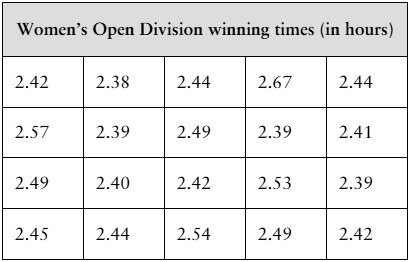Determining a Minimum Sample Size Determine the minimum sample size required when you want to be 99% confident that the sample mean is within two units of the population mean and σ = 1.4. Assume the population is normally distributed.
Table of contents
- 1. Intro to Stats and Collecting Data1h 14m
- 2. Describing Data with Tables and Graphs1h 55m
- 3. Describing Data Numerically2h 5m
- 4. Probability2h 16m
- 5. Binomial Distribution & Discrete Random Variables3h 6m
- 6. Normal Distribution and Continuous Random Variables2h 11m
- 7. Sampling Distributions & Confidence Intervals: Mean3h 23m
- Sampling Distribution of the Sample Mean and Central Limit Theorem19m
- Distribution of Sample Mean - Excel23m
- Introduction to Confidence Intervals15m
- Confidence Intervals for Population Mean1h 18m
- Determining the Minimum Sample Size Required12m
- Finding Probabilities and T Critical Values - Excel28m
- Confidence Intervals for Population Means - Excel25m
- 8. Sampling Distributions & Confidence Intervals: Proportion1h 25m
- 9. Hypothesis Testing for One Sample3h 57m
- 10. Hypothesis Testing for Two Samples4h 50m
- Two Proportions1h 13m
- Two Proportions Hypothesis Test - Excel28m
- Two Means - Unknown, Unequal Variance1h 3m
- Two Means - Unknown Variances Hypothesis Test - Excel12m
- Two Means - Unknown, Equal Variance15m
- Two Means - Unknown, Equal Variances Hypothesis Test - Excel9m
- Two Means - Known Variance12m
- Two Means - Sigma Known Hypothesis Test - Excel21m
- Two Means - Matched Pairs (Dependent Samples)42m
- Matched Pairs Hypothesis Test - Excel12m
- 11. Correlation1h 24m
- 12. Regression1h 50m
- 13. Chi-Square Tests & Goodness of Fit2h 21m
- 14. ANOVA1h 57m
7. Sampling Distributions & Confidence Intervals: Mean
Confidence Intervals for Population Mean
Problem 6.Q.1d
Textbook Question
[APPLET] The winning times (in hours) for a sample of 20 randomly selected Boston Marathon Women’s Open Division champions from 1980 to 2019 are shown in the table at the left. Assume the population standard deviation is 0.068 hour. (Source: Boston Athletic Association)

d. Does it seem likely that the population mean could be greater than 2.52 hours? Explain.
 Verified step by step guidance
Verified step by step guidance1
Step 1: Calculate the sample mean (x̄) of the winning times. Add all the values in the table and divide by the total number of observations (n = 20). Use the formula x̄ = (Σx) / n.
Step 2: Identify the population standard deviation (σ), which is given as 0.068 hours.
Step 3: Compute the standard error of the mean (SE) using the formula SE = σ / √n, where n is the sample size.
Step 4: Determine the z-score for the population mean of 2.52 hours using the formula z = (x̄ - μ) / SE, where μ is the hypothesized population mean (2.52 hours).
Step 5: Compare the calculated z-score to the critical z-value for a chosen significance level (e.g., α = 0.05). If the z-score falls within the critical region, it suggests that the population mean is unlikely to be greater than 2.52 hours. Otherwise, it may be plausible.
 Verified video answer for a similar problem:
Verified video answer for a similar problem:This video solution was recommended by our tutors as helpful for the problem above
Video duration:
3mPlay a video:
Was this helpful?
Key Concepts
Here are the essential concepts you must grasp in order to answer the question correctly.
Population Mean
The population mean is the average of all values in a population. It is a key parameter in statistics that represents the central tendency of a dataset. In this context, it refers to the average winning time of all Boston Marathon Women’s Open Division champions from 1980 to 2019. Understanding the population mean helps in assessing whether the sample mean is a good estimate of the overall average.
Recommended video:

Population Standard Deviation Known
Hypothesis Testing
Hypothesis testing is a statistical method used to make inferences about a population based on sample data. It involves formulating a null hypothesis (e.g., the population mean is less than or equal to 2.52 hours) and an alternative hypothesis (e.g., the population mean is greater than 2.52 hours). By analyzing the sample data, one can determine whether to reject or fail to reject the null hypothesis, providing insights into the population mean.
Recommended video:
Guided course

Step 1: Write Hypotheses
Standard Deviation
Standard deviation is a measure of the amount of variation or dispersion in a set of values. In this case, the population standard deviation is given as 0.068 hours, indicating how much the winning times deviate from the population mean. A smaller standard deviation suggests that the winning times are closely clustered around the mean, while a larger standard deviation indicates more variability, which is crucial for understanding the reliability of the sample mean in estimating the population mean.
Recommended video:
Guided course

Calculating Standard Deviation

 4:48m
4:48mWatch next
Master Population Standard Deviation Known with a bite sized video explanation from Patrick
Start learningRelated Videos
Related Practice
Textbook Question
66
views
